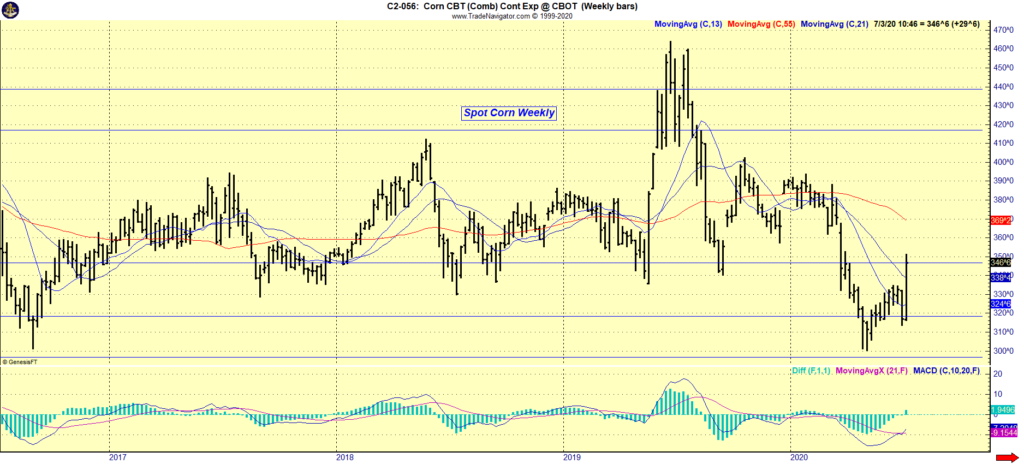Since the financial meltdown in late 2008, we have all become familiarized with the Black Swan Theory. Simply defined, it is a metaphor for an event that comes as a surprise, has a significant effect, and is often inappropriately rationalized after the fact. I suspect that phrase has actually been used far too frequently in the years hence, but I would argue that the corn acreage number issued by the USDA would appear to check off most of the boxes to qualify as one. It was indeed a surprise to the trade, coming in 3 million acres below the average estimate and 1 million below the lowest guesses. It had a significant effect on prices as corn futures posted the biggest single-day gain since October of last year and continue to advance. Finally, everyone is now rationalizing why the estimates were so far askew. Banks put the squeeze on, concerns of COVID-19, wet field conditions, etc., etc., etc. If this does not qualify as a Black Swan event, maybe at least we could label it a Black Duck. I suspect that the large spec community, who came into the report heavily short, are regarding it more as a black cat event.
By no means were all the numbers released “bright and beautiful” as the corn stocks figure as of June 1st came through at over 270 million bushels higher than the average trade estimate, leaving a few people scratching their heads? Realistically the only place where there should be a grey area is feed consumption, and yes, COVID-19 has created more than a few challenges for the sector this year. One has to suspect that cattle have been kept on pasture longer than normal but the backup in the hog industry would if anything suggest higher corn consumption. Keep in mind, quarterly corn stocks have been a bone of contention in the industry for several years and this report did not help clear up the water one bit.
Before moving on, I would like to point out something in the technical picture that I believe is worth noting. Granted, we still need to finish the week, but on the weekly corn chart, we have the MACD crossing into positive territory this week. While there is no technical signal that is correct all the time, I have watched this indicator literally for decades, and it has more often than not been a good indicator for general trend direction, particularly when the averages cross each other while not sitting around the zero line. By no means am I going to suggest that this signals we have moved into a bull market in corn, but would believe it tells us, this is more than a one-hit-wonder, and could extend further than just your typical technical bounce. All that said, for producers, get ready to take advantage of additional strength this month.
It is not my intention to disregard the bean figures on yesterday’s release as they were generally positive as well. Many would have assumed that if there were a big decrease in corn acres (as well as cotton), those would have found their way into beans, but that was not the case. Soybean acres only increased 315,000 from the March estimate, and quarterly stocks were just a smidge below the average estimate. As it turns out, the total acreage planted to principal crops this year declined over 2% from the March estimate and at 311.9 million, is the smallest since 1993. Realistically, this is what needs to happen as U.S. agriculture adjusts to the reality of current global production and usage. Markets will now shift focus to weather and the July production and supply/demand reports that will be issued on the 10th.
If China keeps this up, they are not going to have anyplace to source meat from. They have now halted nearly all pork imports from the Netherlands after COVID-19 outbreaks in four of the largest Dutch processing facilities. While no timeline was provided for how long this would remain in place, Dutch authorities have stated they are willing to cooperate with Chinese demands for inspections. Last year this nation exported 299,000 MT of pork to China.
COVID does not appear to have hampered the exports of beans and corn from Brazil. During June, it is estimated they loaded out 11.9 MMT of beans, a 37% increase over last year, and nearly 775,000 MT of corn. In July, they are expected to move an additional 7.25 MMT of beans and 3.9 MMT of corn as the safrinha crop becomes available. During the first half of this year, China has accounted for 72% of all the beans shipped.
Last but not least this morning, both of Iowa’s Senators have now stepped up to challenge the obviously pro-oil leadership at the EPA. Late last week Joni Ernst said that she would block the nomination of Doug Benevento as deputy administrator until there was clarification as to how the department will handle petitions to grant extensions to biofuel blending exemptions. (That is a mouthful) There are 52 such petitions that have been requested. Yesterday, Senator Chuck Grassley joined his colleague in supporting her maneuver.
